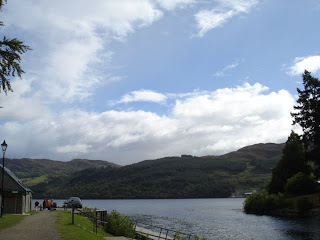Police Tried to Protect 'Nessie' From Hunters
Lee Spiegel, Contributor
(April 28)(AP) -- A Scottish police chief in the 1930s believed the Loch Ness monster existed and tried to protect the unknown animal from hunters who targeted "Nessie" with harpoons.
Documents released this week by the National Archive of Scotland reveal that, in the 1930s, local authorities tried to get the Scottish government to protect and defend the famous monster of the deep, dark waters of Loch Ness.
Documents released this week by the National Archive of Scotland reveal that, in the 1930s, local authorities tried to get the Scottish government to protect and defend the famous monster of the deep, dark waters of Loch Ness.
A 1938 letter written by Chief Constable William Fraser stated, "That there is some strange creature in Loch Ness now seems beyond doubt, but that the police have any power to protect it is very doubtful."
The news comes as no surprise to those who are still trying to confirm the legendary monster's existence.
"I think that there are gigantic, unknown seals that have yet to be discovered from all of the Northern Hemisphere lakes, and Loch Ness is a prime example," said Loren Coleman, who runs the International Cryptozoology Museum in Portland, Maine.
As a result of the many reports in the 1930s of strange creatures in the lake, several hunting parties came to the area looking for them, including a couple who showed up in 1938 and wanted to use a harpoon to capture one of the animals so they could prove that a Loch Ness monster was obtainable.
Coleman, 62, thinks the release of Fraser's letter is overwhelmingly important because it validates that the Scottish government -- despite public pronouncements to the contrary -- at the time was secretly concerned that there were real creatures there and wanted to protect the "monsters," or unknown animals that lived in the lake.
"It's a breeding population -- there have been multiple sightings of more than one creature," said Coleman, who in 1999 gave the keynote address to the first International Cryptozoology Symposium ever held at Loch Ness.
"The other big thing that nobody talks about," he told AOL News, "is that it's only six miles to the ocean, and there have been about 27 sightings of these creatures on land, crossing the road, and described as a walrus-type animal or a big slug."
Given the strangeness of whatever it is that inhabits the famous Scottish loch comes under the purview of cryptozoology, which is the study of hidden or as-yet-undiscovered animals.
Whatever lurks in Loch Ness has a long history, dating back to A.D. 565, when the first monster sighting was recorded. Over the centuries, many sightings and photos of a creature (or creatures) have fueled speculation that there might be a surviving dinosaur species in the lake. But it's important to protect these animals, says Coleman, who's considered the world's leading living cryptozoologist.
"I think that any species like this that hasn't easily been found are certainly low in numbers. And the last thing we want to encourage is to think that people, looking for a pot of gold, can go out there and hunt these creatures to near extinction. We really have to undermine the greed motivation that is behind a lot of these hunters." And, Coleman says, what the Loch Ness monster eventually turns out to be will most likely shake science up.
The news comes as no surprise to those who are still trying to confirm the legendary monster's existence.
"I think that there are gigantic, unknown seals that have yet to be discovered from all of the Northern Hemisphere lakes, and Loch Ness is a prime example," said Loren Coleman, who runs the International Cryptozoology Museum in Portland, Maine.
As a result of the many reports in the 1930s of strange creatures in the lake, several hunting parties came to the area looking for them, including a couple who showed up in 1938 and wanted to use a harpoon to capture one of the animals so they could prove that a Loch Ness monster was obtainable.
Coleman, 62, thinks the release of Fraser's letter is overwhelmingly important because it validates that the Scottish government -- despite public pronouncements to the contrary -- at the time was secretly concerned that there were real creatures there and wanted to protect the "monsters," or unknown animals that lived in the lake.
"It's a breeding population -- there have been multiple sightings of more than one creature," said Coleman, who in 1999 gave the keynote address to the first International Cryptozoology Symposium ever held at Loch Ness.
"The other big thing that nobody talks about," he told AOL News, "is that it's only six miles to the ocean, and there have been about 27 sightings of these creatures on land, crossing the road, and described as a walrus-type animal or a big slug."
Given the strangeness of whatever it is that inhabits the famous Scottish loch comes under the purview of cryptozoology, which is the study of hidden or as-yet-undiscovered animals.
Whatever lurks in Loch Ness has a long history, dating back to A.D. 565, when the first monster sighting was recorded. Over the centuries, many sightings and photos of a creature (or creatures) have fueled speculation that there might be a surviving dinosaur species in the lake. But it's important to protect these animals, says Coleman, who's considered the world's leading living cryptozoologist.
"I think that any species like this that hasn't easily been found are certainly low in numbers. And the last thing we want to encourage is to think that people, looking for a pot of gold, can go out there and hunt these creatures to near extinction. We really have to undermine the greed motivation that is behind a lot of these hunters." And, Coleman says, what the Loch Ness monster eventually turns out to be will most likely shake science up.



No comments:
Post a Comment